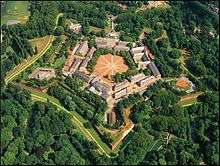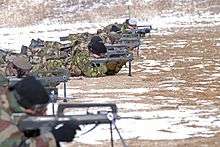Headquarters Rapid Reaction Corps – France
| HQ RRC-Fr | |
|---|---|
 | |
| Country | France |
| Type | Headquarters |
| Garrison/HQ | Lille |
| Commanders | |
| Current commander | Lieutenant General Eric MARGAIL |

Headquarters Rapid Reaction Corps-France (HQ RRC-FR), created on 1 July 2005, is a French headquarters, NATO certified, able to command a national or multinational land component of between 5,000 and 60,000 personnel.
With more than 400 military coming from thirteen different nations, HQ RRC-FR is stationed in Lille, within a 17th-century citadel also known as "the Queen of the Citadels", designed by the famous French Field Marshal Vauban.
Reactive, flexible and "open to the world", HQ RRC-FR is a purpose-built organisation, designed to handle the complexity of military operations of the early twenty-first century.

Reactive
Following a detailed examination of its capabilities, the Headquarters Rapid Reaction Corps-France was certified High Readiness Force (HRF) by NATO in July 2007. Only seven headquarters are certified as such in Europe.
Once placed on alert, it is able to deploy reconnaissance teams to an operation area within two days, following a political decision to commit troops, and a light command post (CP) in less than ten days.

Flexible
HQ RRC-FR is able to perform a wide variety of missions, ranging from an initial entry to stabilisation operations.[1]
It can be committed within a multinational environment, in the framework of NATO, European Union (EU) or even under a national mandate. Thus:
- From 1 July to 31 December 2008, it assumed NATO Response Force (NRF11) Land Component standby period.
- From January to May 2009, part of the HQ staff members contributed to reinforce European Force (EUFOR) in Chad and the Central African Republic.
- From August 2010 to January 2011, about 180 personnel (including about thirty allies) were deployed to Afghanistan, to man part of the positions of ISAF (International Security and Assistance Force) tactical headquarters positions, ISAF Joint Command (IJC).
Indeed, in the planning process of NATO-led operations in Afghanistan, NATO certified headquarters (including HQ RRC-FR) regularly contribute to ISAF rotations.
- Until the end of 2014, HQ RRC-FR assumed NATO Response Force (NRF) Land Component standby period.
- In 2015, HQ RRC-FR celebrates its 10th anniversary.
- In 2015-2016, deployment of a part of the Headquarters in the Joint Command Post of operation BARKHANE in Africa.
- In 2017, NATO Joint Task Force (JTF) certification.
- Summer 2017: beginning of the NATO JTF standby period.
In the same time, French Members of RRC-FR’s staff are contributing to the operation Sentinelle [2] as all French army operational units.
Open to the world
HQ RRC-FR completes the range of French Land Forces Headquarters. Its creation allows France to contribute according to its position and international commitments, while remaining consistent with the requirements of national security and defence, within the framework of the EU or NATO.
A multinational headquarters subordinated to Land Forces Command (LFC) based in Lille, the HQ RRC-FR is open to all EU and NATO members (16% of its strength). Though stationed in France, its working language is English.
In crisis, French and Allied operational reinforcements would augment its strength up to 750 personnel, to enable HQ RRC-FR to conduct long term high intensity operations.

Focus on…
Thirteen contributing nations
In addition to France, HQ RRC-FR framework nation, thirteen different nations contribute to the staff on a permanent basis, representing a total of 60 to 80 personnel.
Everything is done to draw on the military experience of each nation. A constant exchange is facilitated by the use of English as a common working language.
- NATO and European Union members
- NATO members
A 21st-century headquarters
HQ RRC-FR benefits from the best fibre-optic-equipped site among the French Army: about 300 km fibre deployed between and inside its 17th-century walls. There, are 18 (French + NATO) computer and phone networks.
All of them can be projected, via satellite link to an operational theatre providing HQ RRC-FR with the capacity to command, if needed, an operation from its Citadel based Command Post, thanks to a rear Homebase Operation Center (HBOC).
As for now, HQ RRC-FR benefits from the sole French phone exchange directly connected to the NATO network.
A 24 person-team is responsible for assembling, maintenance and operation on these networks, which offers HQ RRC-FR complete autonomy in this domain, compared to other headquarters.
When deployed, HQ RRC-FR can use up to five thousand square metres of tentage, four hundred and fifty modular CP shelters, seventy kilometres of electrical cable, one hundred and twenty kilometres of fibre optics and sixteen hundred computers.
A strategic crossroads
In between Paris, Brussels (NATO and EU Headquarters), Mons (SHAPE Headquarters) and Strasbourg, (European Parliament), HQ RRC-FR is ideally located towards key decision centres.
It has been certified as a "High Readiness Force" (HRF) by NATO since 2007.
See also
References
- ↑ Stabilisation operation: creating the necessary conditions for the normalisation of the situation, particularly in the field of security, and thereby enabling functioning state institutions.
- ↑ Operation Sentinelle: French domestic mission which intends to support security forces in preventing terrorist attacks on the French territory.